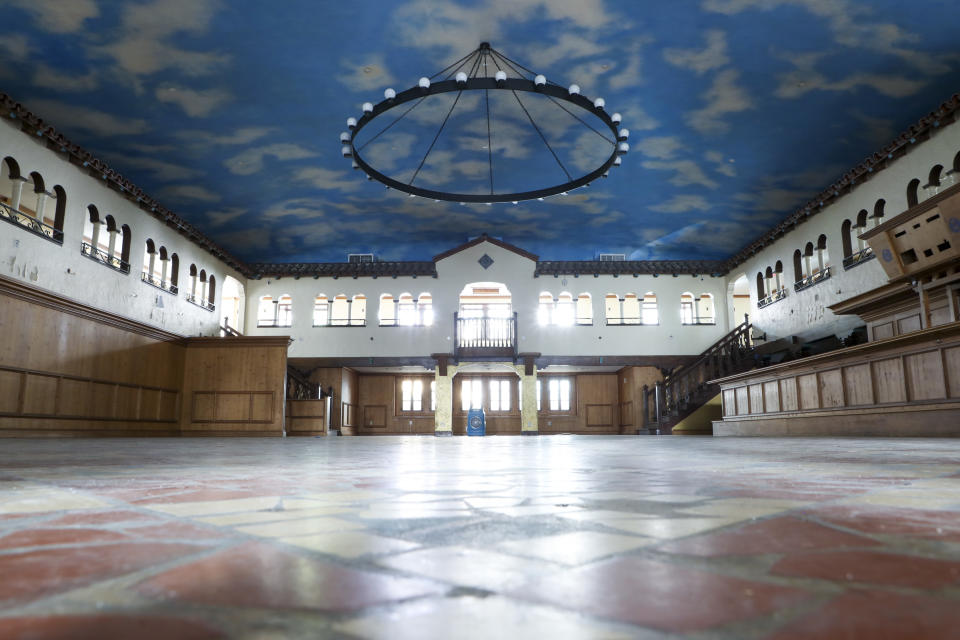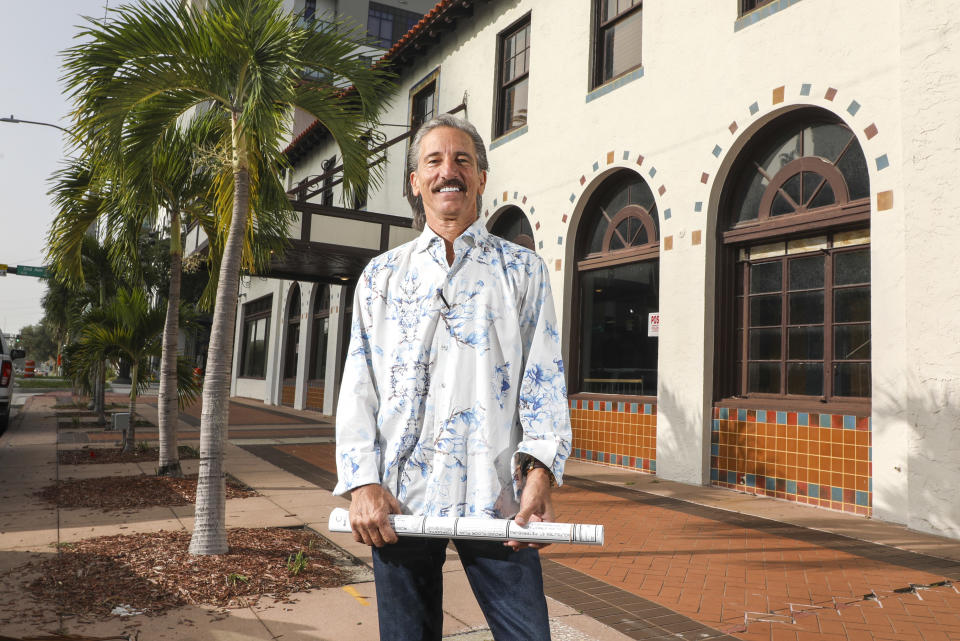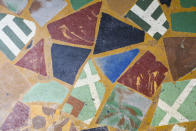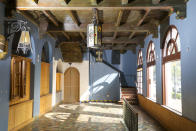How St. Pete’s historical Tramor building will transform into a sleek lounge
ST. PETERSBURG — GolfSuites CEO Jerry Ellenburg had plans for a sleek modern storefront for his next golf simulator lounge. Then he walked through the Art Deco doors of the former Tramor cafeteria in downtown St. Petersburg and those plans went out the wrought iron windows.
His company already owns three outdoor golf simulator event spaces in other states, similar to Topgolf, that offer an entertainment space in which people can practice their swing and play on a virtual version of famous courses while snacking on chicken wings and sliders. He has a 20-year lease agreement in St. Petersburg for a different take on the concept.
“This will be a classier version of a simulator lounge. With GolfSuites City Club, we are bringing the country club into the city,” said Ellenburg, who plans to expand the high-end concept to more cities across the country.
The ghosts from the nearly 100-year history of the building that was last the German beer hall Hofbrauhaus are haunting Clearwater-based architect Robert Resch. He is tasked with putting big screens and computerized simulations of famous golf courses into this downtown building that once fed Depression-era diners and World War II soldiers.
Built in 1929, it is a prime example of the Mediterranean Revival style of architecture that was all the rage in the roaring ‘20s during St. Petersburg’s first boom period. It sits at the intersection of First Avenue South and Fourth Street, with a barrel tile roof and towering corners. It has an intricately tiled lobby with thick cypress beams overhead that opens into an expansive interior designed to create the illusion of a Spanish hacienda.
There is a balcony that wraps around the central dining space. Red barrel tile tops the arched windows that encircle a dining area that looks like a courtyard. The floor is tiled in colorful adobe squares, and glazed Mexican tile decorates the walls. The ceiling is painted blue, with clouds drifting across the “sky.” It looks like a scene right out of Disney’s “Encanto,” where the casita with its magical doors and central courtyard is a character itself.
The building sprang up during the Jazz Age at the same time as other local jewels, including the Vinoy and the Don CeSar hotels. The cafeteria catered to tourists and seasonal residents who did all their shopping downtown and could get a cheap meal at the Tramor (its name is said to have come from the idea that there’s “more on the tray”). In the 1940s and ‘50s, it drew in customers with a Friday night lottery that could win you a free ticket to Cuba.
The 17,000-square-foot building will reopen its doors next summer as GolfSuites’ newest concept, called the City Club. The Brandon-based company, which already operates three outdoor driving range entertainment facilities in Oklahoma, Texas and Louisiana, likens the newest concept to a country club.
It has snagged Kevin Harrington, an original Shark on the ABC hit and Emmy-winning TV show “Shark Tank.” The inventor of the infomercial joined the company as board director and will be the “brand ambassador” for the GolfSuites City Club brand nationwide as it expands.
So, what will the new experience be like? There will be lounges with hyper-realistic golf simulators set in a “living room style,” architect Resch said. Memberships will be sold to give priority for reservations and other perks, though it will be open to the general public. Mornings will feature golf lessons on the simulators.
It will have a high-end dining menu featuring scallops and prime rib, and the bar and restaurant will have seating for more than 300, both inside and out.
Resch noted that the 1920s saw the beginning of golf in the U.S., so the pairing could be seen as a natural connection. Gatsby goes to Pebble Beach? He’s not sure he can go that far. But by highlighting a rich dining atmosphere in a historic space, it won’t feel like a video game either.
“We will be contrasting the old and the new, the future,” he said.
The two-story interior space will stay largely intact, he said, though its famous azure ceiling with painted clouds will be changed, he said, to a midnight blue, “like when the sun first comes up in the morning.”
It will still look like a sky, he said, but without stars or clouds that could interfere with the conditions needed for the projection screens.
“Instead of highlighting the ceiling in the sky, we will be highlighting all of this architecture,” Resch said. “We will be comparing and contrasting what golf has done in 100 years. It’s super high tech in an antique environment.”
Previous owners had plans to gut the building and turn it into a food hall, similar to Tampa’s Armature Works. Other planners have eyed the prime real estate, which is surrounded by huge condominiums and office towers under construction across downtown St. Petersburg. There was pressure to maximize the space, Resch said.
Resch said he plans to restore its original 1929 finishes and materials. The front lobby will be full of 1920s artwork and old photos. The second level will have gallery dining with a view of the golf simulators below, and there will be seating outside.
“It will be an indoor-outdoor playground, but it’s not going to be T-shirts and tank tops. This is going to be a city club, different than all the concepts across the area,” Resch said.
Resch, 65, who graduated from Dunedin High School and the University of Florida’s school of architecture, worked with Ellenburg two decades ago when he brought downtown Clearwater its first Starbucks in the revitalized 1926 Wiseman Building, turning it into the Matrix Lodging headquarters. Resch himself lives in a 1925 home in Clearwater’s Glenwood Estates, so he knows how tough it can be to work on historic buildings.
He views the project as a reflection of both the history of golf and the future of golf projected in one space.
“I want to keep the integrity and history of the building, because there are people whose grandmothers used to dine there, whose grandfathers served in the armed forces and had all their meals there,” he said. “That building someplace else wouldn’t make any sense. It’s a cornerstone of St. Petersburg.”












